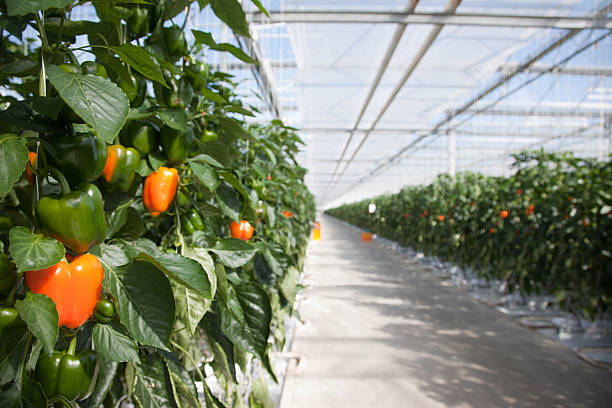Cultivating capsicum, also known as bell peppers or sweet peppers, can be a highly rewarding agricultural endeavor when the right soil and climate conditions are met. Capsicum is sensitive to environmental factors, and optimizing these can significantly enhance both yield and quality. In this comprehensive guide, we will delve into the specific requirements for soil and climate to ensure a successful capsicum cultivation process.
Understanding Capsicum’s Soil Requirements
1. Soil Texture and Structure
Capsicum plants thrive best in well-drained, loamy soils. Loamy soil is a balanced mix of sand, silt, and clay, which provides the right amount of moisture retention and drainage that capsicum needs for healthy root development. Poorly drained soils can lead to root rot, while overly sandy soils may not hold enough water.
- Ideal Soil Texture: Loam (40% sand, 40% silt, 20% clay)
- Soil Structure: Loose and crumbly for proper aeration.
2. pH Levels and Nutrient Content
Soil pH plays a critical role in nutrient absorption. Capsicum prefers a slightly acidic to neutral pH, typically ranging between 6.0 and 7.0. Testing the soil pH before planting is crucial. If the soil is too acidic, lime can be added to raise the pH. In contrast, sulfur can help lower overly alkaline soils.
Key nutrients capsicum requires include:
- Nitrogen (N): Essential for vegetative growth.
- Phosphorus (P): Promotes healthy root development.
- Potassium (K): Enhances fruit quality and disease resistance.
Incorporating organic matter like compost or well-rotted manure into the soil is highly beneficial, as it improves soil structure and provides a slow release of nutrients throughout the growing season.
3. Drainage and Water Holding Capacity
While capsicum enjoys moisture, waterlogged soils can be detrimental to the plant. Excess water can lead to oxygen deprivation in the roots, which negatively impacts growth. The soil should have good water-holding capacity but drain efficiently to prevent stagnation. Raised beds are an excellent solution for areas prone to water retention, as they help with better drainage.
4. Organic Matter and Fertilization
A high level of organic matter is essential for maintaining healthy capsicum crops. Adding compost or green manure during soil preparation will increase the microbial activity, improve soil structure, and enhance nutrient availability. It is also advisable to conduct a soil test to determine the nutrient levels and fertilization needs. A balanced fertilizer (such as NPK 10-10-10) can be used to supplement nutrient gaps.
- Recommended organic matter: 3-5% of soil composition.
Optimal Climate for Capsicum Cultivation
1. Temperature Requirements
Capsicum is a warm-season crop, sensitive to both frost and extreme heat. It grows best in temperatures between 20°C and 30°C. Temperatures below 15°C or above 35°C can hinder growth, lead to poor fruit set, and increase susceptibility to diseases. Additionally, day-night temperature variation influences flower and fruit development. A consistent day temperature of around 25°C with cooler nights promotes healthy fruiting.
Key temperature thresholds:
- Optimal range: 20°C to 30°C
- Minimum temperature: 15°C (below which growth stagnates)
- Maximum temperature: 35°C (higher temperatures reduce fruit quality)
2. Humidity Levels
Capsicum thrives in moderate humidity levels, ideally between 50% and 70%. Low humidity can cause wilting, and high humidity encourages fungal diseases such as powdery mildew and anthracnose. Proper spacing between plants and good air circulation are crucial to maintaining healthy humidity levels, particularly in tropical and subtropical regions where humidity can be excessive.
3. Rainfall and Water Management
Although capsicum needs regular watering, especially during the initial stages of growth and fruit development, overwatering or prolonged wet periods can be detrimental. Capsicum does best with moderate rainfall (around 600 to 900 mm annually), but in areas with high rainfall, controlled irrigation is necessary to avoid water stress or fungal infections. The use of drip irrigation is a recommended method to provide consistent moisture while minimizing water waste.
- Rainfall needs: 600-900 mm annually.
- Water management: Drip irrigation is preferred for efficient water use.
4. Sunlight Exposure
Capsicum plants require full sunlight for at least 6-8 hours per day. Adequate sunlight is essential for photosynthesis, which in turn drives the growth and productivity of the plant. Lack of sunlight leads to weak stems, fewer flowers, and smaller, lower-quality fruit. Shading should only be considered in regions with intense heat to prevent heat stress.
5. Wind Protection
In regions with strong winds, it’s important to provide windbreaks or plant capsicum in sheltered areas. High winds can cause mechanical damage to the plant, especially during the flowering and fruiting stages. Wind also increases transpiration, which can lead to dehydration if water is not readily available.
Conclusion: A Holistic Approach to Capsicum Cultivation
To achieve successful capsicum cultivation, it is essential to consider both the soil quality and the climatic conditions. Proper soil management, including attention to texture, pH, and nutrient content, paired with careful selection of a suitable climate, will maximize yields and produce high-quality fruits. Consistent monitoring of these factors, along with adaptive farming techniques such as raised beds, organic fertilizers, and drip irrigation, ensures that capsicum plants are well-nourished and grow in ideal conditions.
Capsicum farming is a delicate balance between soil health and environmental conditions. By ensuring that both these aspects are optimized, farmers can look forward to abundant and high-quality capsicum harvests.





